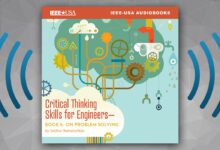
IEEE-USA President Ron Jensen began his brief speech at the Future City Competition National Finals on 22 February with something he had been longing to say for a couple of days.
“Happy National Engineers Week,” Jensen said at the Hyatt Regency Washington on Capitol Hill. “It wouldn’t have made much sense for me to say it at the airport, or in the hotel lobby, but here it just feels right. And it feels good.”
IEEE-USA created and staged the first Future City, an engineering design competition for middle school students, in its offices in 1993. Today, about 33,000 students participate. Thirty-five regional champions earned all-expenses-paid trips to Washington. Teams are made up of three students, a teacher and their engineer mentor. Additional students often work behind the scenes on other important aspects of the contest, including the essay.
Jensen presented plaques to the third-place team, Davidson (N.C.) IB Middle School, last year’s national champion; and the Alexander Dawson School of Las Vegas, the winner of the IEEE-USA Best Communications System Award. IEEE members Murty Polavarapu and Kiki Ikossi judged the communications award.
Don Wittmer, P.E., regional coordinator and National Finals judging coordinator, continues to be amazed by the cities the students design. “I know I wasn’t as smart as these kids when I was their age,” Wittmer said amid laughter during a judges meeting, “and I’m probably not as smart now.”
Engineers Week (EWeek) activities in the nation’s capital kicked off on Saturday, 19 February, with the annual Discover Engineering Family Day at the National Building Museum. The event, which also began under IEEE-USA’s leadership in 1993, set a new single-day museum attendance record with 13,994 parents, teachers and youngsters. The previous Family Day record, set in 2009, was 8,178.
“We were pleased to welcome thousands of new visitors to the museum for a safe, educational and enjoyable day,” said Joanne Seelig, National Building Museum family programs coordinator.
Family Day brings hands-on and thought-provoking engineering-related activities to children to introduce them to engineering and promote technical literacy. At IEEE-USA’s exhibit, youngsters learned about what materials conduct electricity and how a basic electrical circuit works. IEEE-USA volunteers and staff stressed the role that engineers play in designing, installing and operating power systems, to educate attendees on the engineering behind the safe, effective and reliable delivery of electricity.
On Monday, 21 February, the 2011 IEEE/IEEE-USA New Face of Engineering, Sampathkumar Veeraraghavan, was featured alongside other engineers under 30, in a full-page ad in USA Today.
During his trip to Washington, D.C., IEEE-USA President Jensen also attended the National Academy of Engineering Awards Dinner Ceremony and Presentation at the East Hall of Union Station. The black-tie event is the U.S. engineering profession’s most prestigious awards gala.
Frances H. Arnold and Willem P.C. Stemmer were among the four awardees. They were honored with the Charles Stark Draper Prize “for directed evolution, a method used worldwide for engineering novel enzymes and biocatalytic processes for pharmaceutical and chemical products.” Arnold is the first woman to receive the Draper Prize. She and Stemmer received gold medals and will share $500,000.
Chris McManes is IEEE-USA’s public relations manager.






